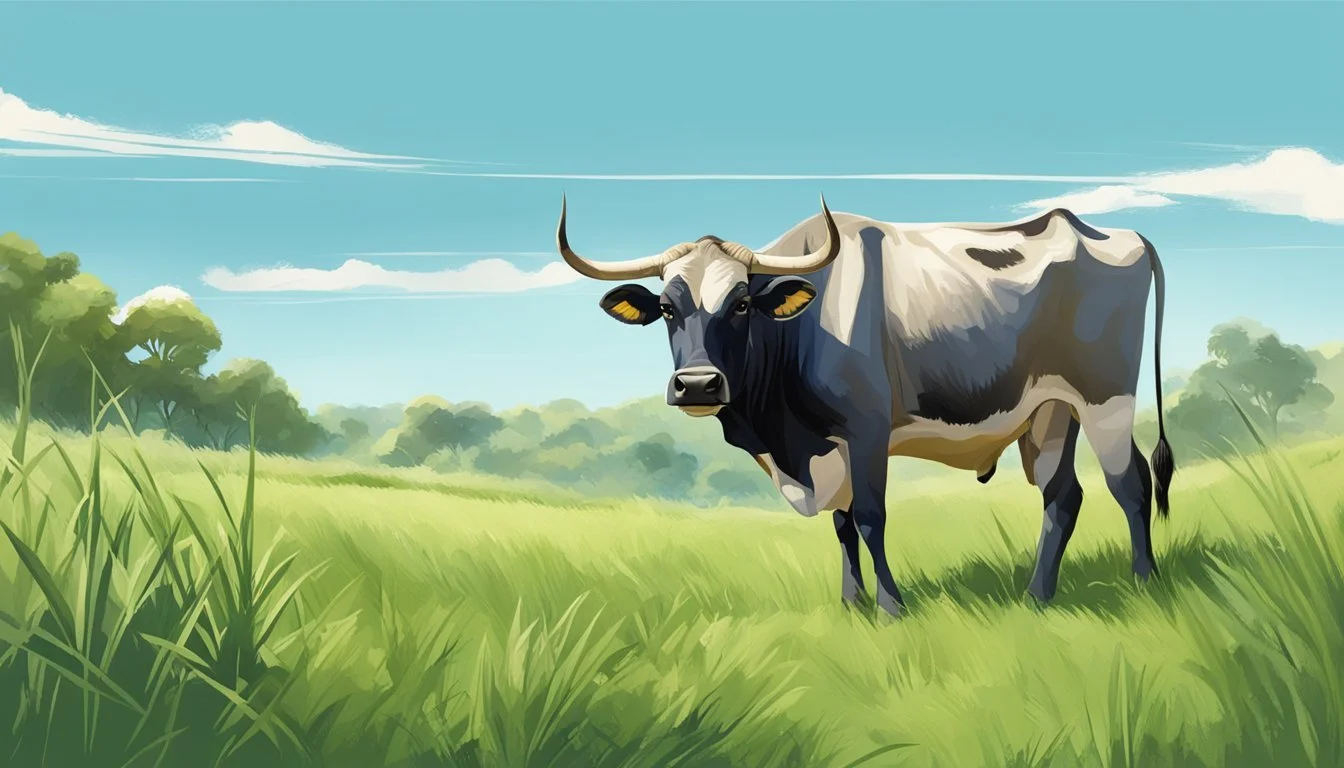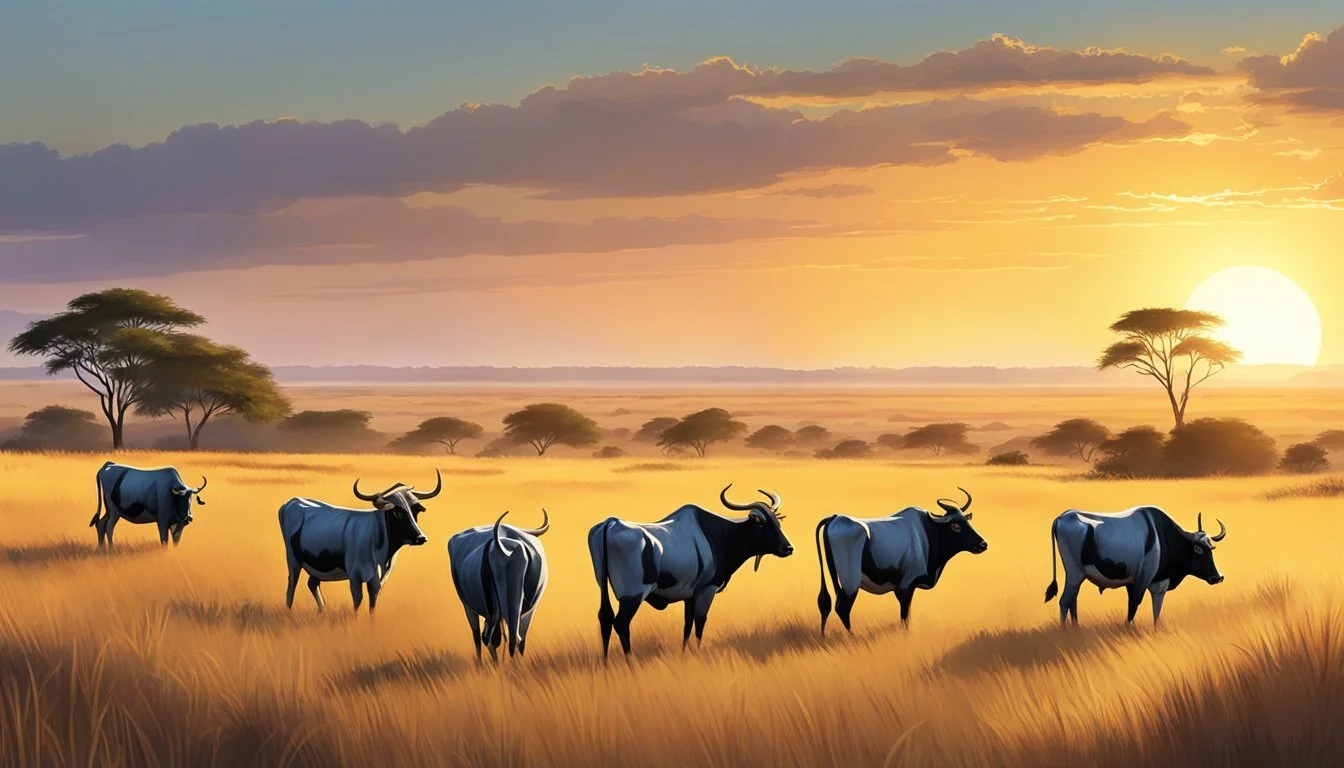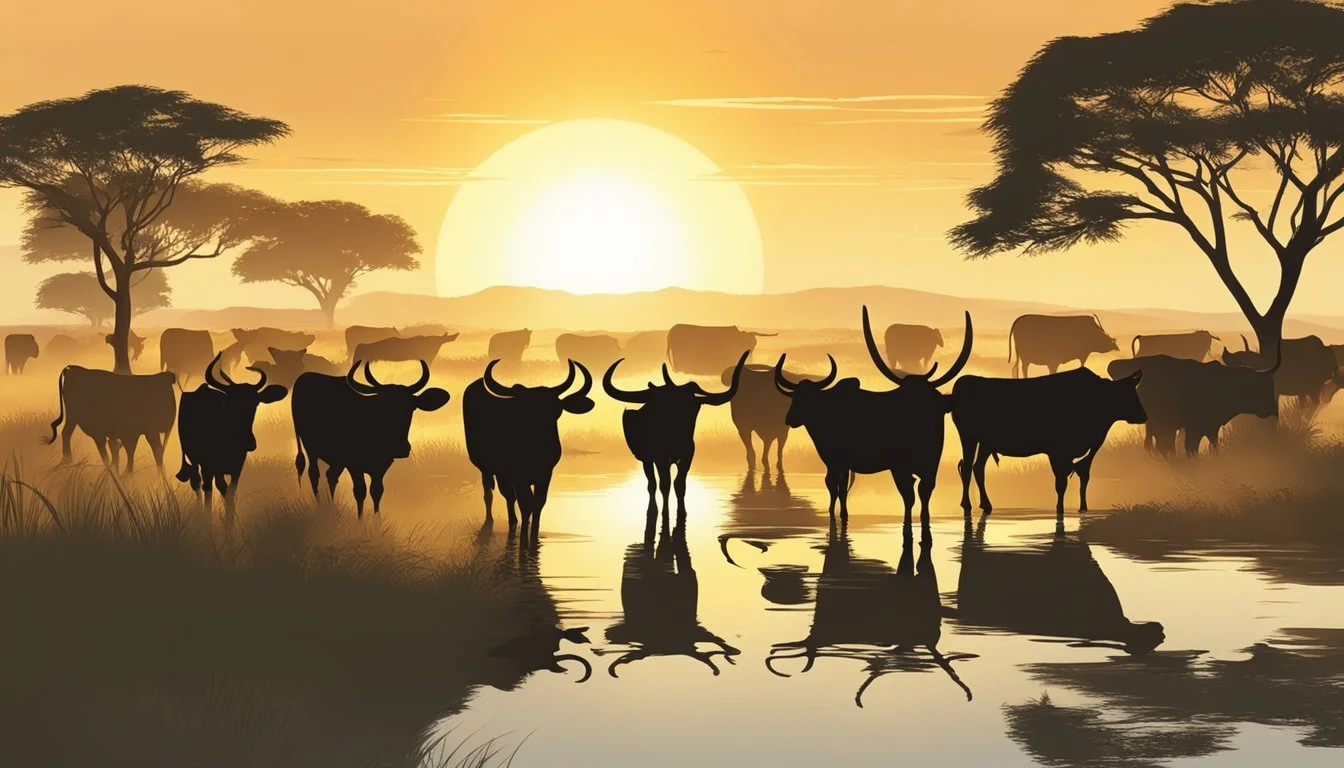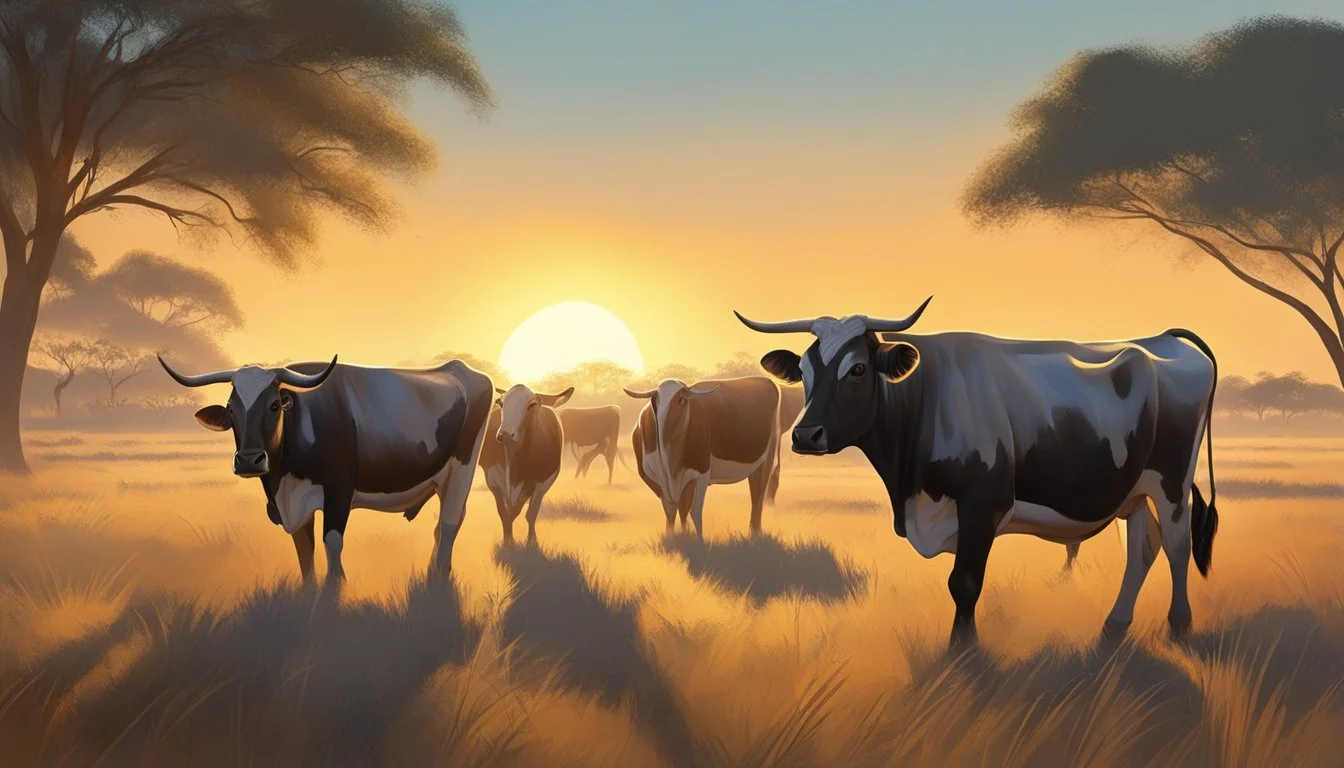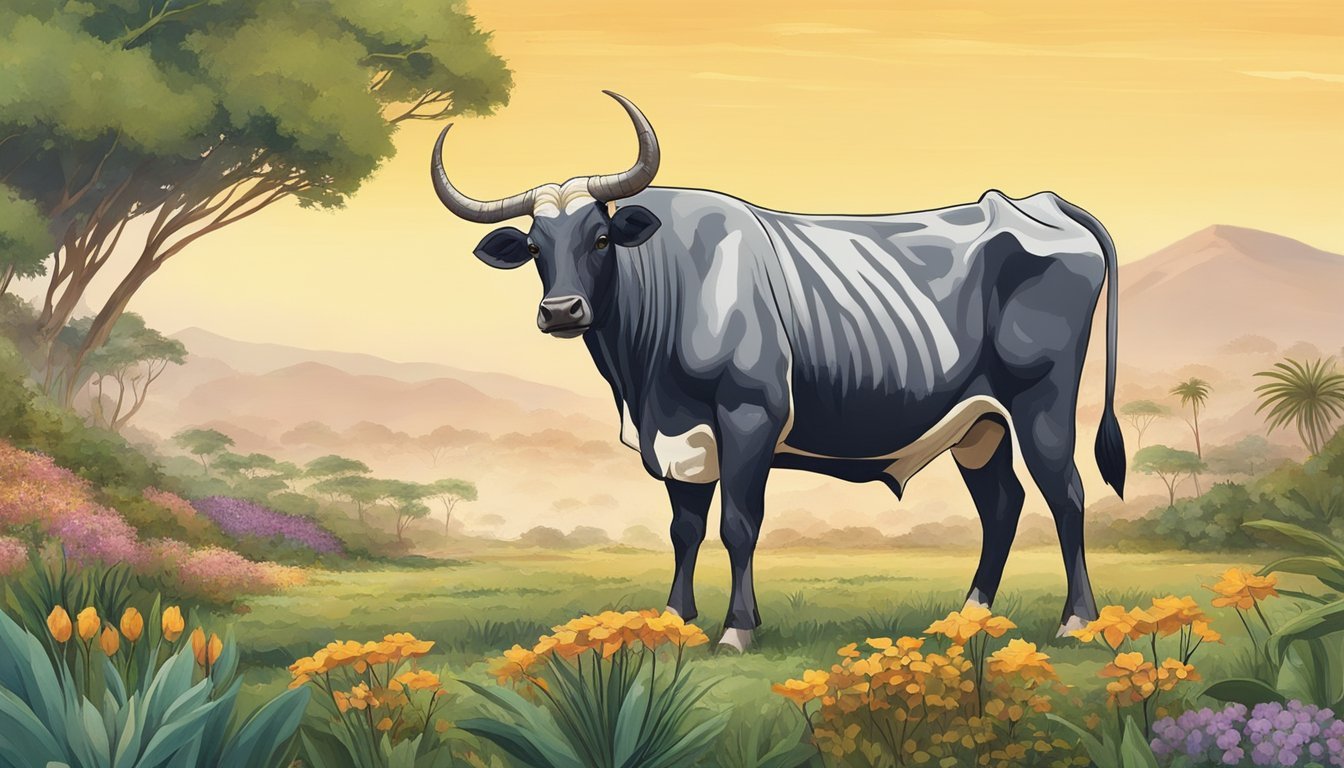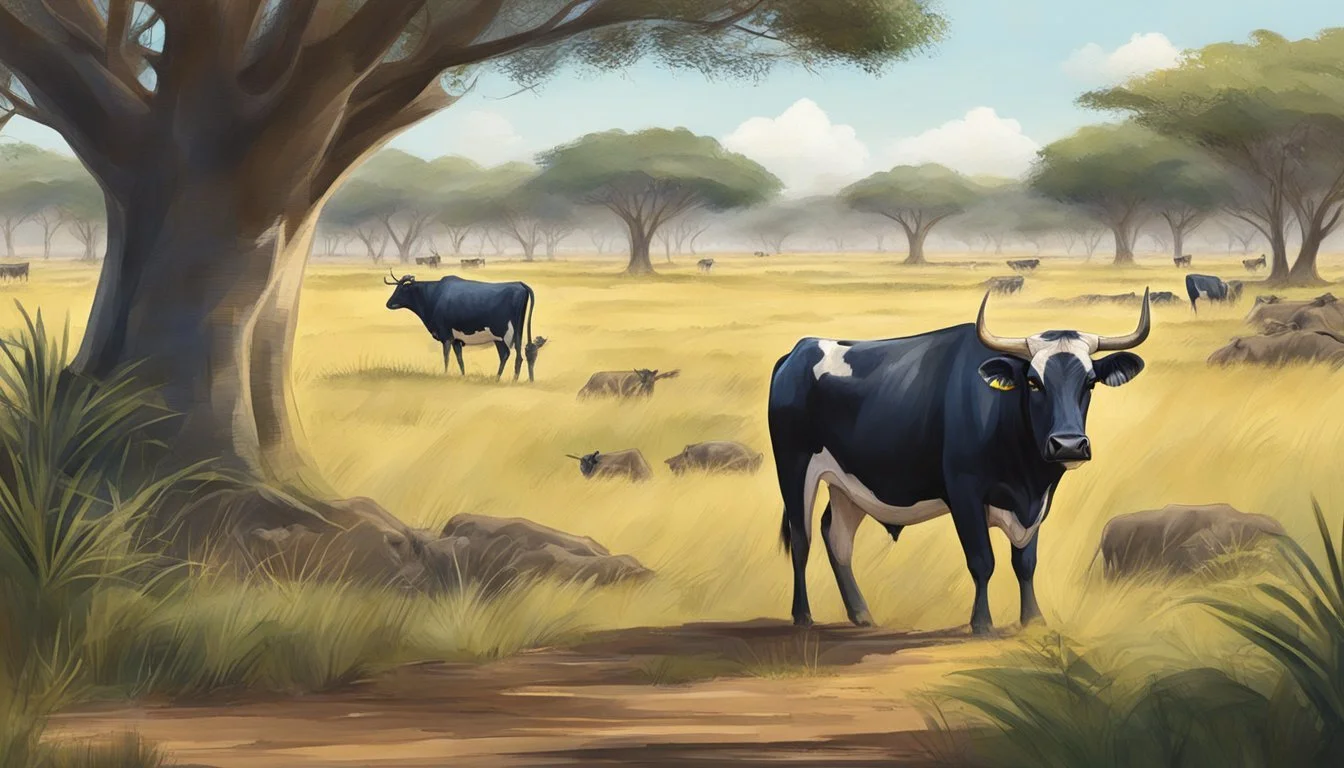Zebu
A Cornerstone of Exotic Meat Cuisine in Africa
Zebu cattle, distinguished by their humped back and large drooping ears, are a breed of domestic cattle originating from the Indian subcontinent but can be found in various African regions. Over time, Zebu has been integrated into the local ecosystems and become a regular part of the agricultural and culinary landscapes of several African countries. Notably, the meat from Zebu is recognized for its significance in traditional dishes, and as such, Zebu has secured its place as a staple in exotic meat cuisine.
The resilience of Zebu cattle makes them particularly well suited to the diverse and often harsh climates of Africa. Their ability to withstand high temperatures and resist diseases common to tropical regions has led to their widespread utilization across the continent. Farmers value Zebu cattle not only for their meat but also for their use in labor and their adaptability to varied environmental conditions. As a source of sustenance and economic stability, Zebu contributes significantly to the food systems and communities where they are raised.
In the culinary world, Zebu meat is appreciated for its distinctive flavor and is a sought-after ingredient in many traditional African dishes. It is often found in various forms, from grilled cuts to stews, and is known for its lean quality and rich taste that differentiates it from other types of beef. The significance of Zebu in African cuisine is an interesting intersection of agriculture, gastronomy, and cultural heritage, representing a unique facet of the continent's diverse food culture.
Zebu Origins and History
The history of Zebu cattle, scientifically known as Bos taurus indicus, is deeply rooted in African and Asian regions, with a legacy of domestication that reshapes the narrative of ancient agriculture and civilization.
African and Asian Lineage
Zebu cattle are believed to have originated from South Asia, with genetic lineages tracing back to the Indian subcontinent. Over time, their descendants branched out and became a prominent feature in African pastoral cultures. Their distinguishing characteristics include a significant fatty hump, a large dewlap, and in some cases, drooping ears, which are the result of their adaptation to various environmental challenges.
Domestication and Distribution
Archaeological evidence suggests that the domestication of Zebu cattle occurred in Asia over thousands of years, tracing back to the auroch ancestors. These animals gradually spread to East Africa and beyond, aided by human migration and trade. Zebu cattle possess traits that make them well-suited for tropical climates, such as resistance to drought and some parasites, a factor that has influenced their widespread distribution.
Influence of Zebu in Ancient Cultures
In ancient cultures, particularly in India and Africa, Zebu cattle were more than just domesticated animals for agriculture; they held significant cultural and economic importance. By virtue of their resilience and utility, Zebus played a pivotal role in the development of civilizations, figuring prominently in agricultural practices, trade, and even religious contexts. The history of Zebu is intertwined with the histories of the people and countries they sustained.
Anatomical Characteristics
Zebu cattle are distinctive for their physical adaptations, which include a notable hump and a range of features suited for their environments. Throughout various breeds, these cattle display an array of characteristics concerning their size, weight, and coat.
Distinctive Hump
The hump on a Zebu's back is its most identifiable feature. It is located over the shoulders and is composed of fat, serving as an energy reserve. This adaptation is particularly beneficial for survival in climates where food and water may be scarce.
Adaptive Features
Beyond their hump, Zebu cattle possess several other adaptations. They display a significant dewlap, which is the loose skin hanging beneath the neck, and often have droopy ears. These features, along with the hump, play crucial roles in thermoregulation and adaptation to hot, arid environments. Their coat can vary in color, commonly gray or red, and the skin is typically thick to protect against heat and insect bites.
Horns: Present in both males and females, the horns of Zebu cattle aid as a defense mechanism.
Lifespan: Zebus have a comparatively long lifespan, serving both as dairy and draft animals in their regions.
Size and Weight: They are smaller in stature, with mature individuals reaching up to 3.5 feet at the shoulder and weighing up to 600 lbs or more.
Variations Among Breeds
While the Zebu is considered one breed, it encompasses a variety of breeds with their own unique attributes. Some notable breeds include Guzerat, Nelore, and Gir, each contributing genetically to the diversity within the overarching group known as Zebu. These breeds exhibit variations in size, coat color, ear size (from large flopping to smaller ears), and the prominence of the hump and dewlap, which can dictate their suitability for different purposes like milk production or meat.
Zebu in Agriculture
The Zebu cattle breed plays a crucial role in agriculture, particularly in parts of Africa and Asia, where they are utilized both for their physical capabilities and the by-products of their breeding. Renowned for their adaptability and resilience, Zebu are an essential resource for farmers and agriculturalists.
Role as Draft Animals
In their function as draft animals, Zebu bulls and oxen exhibit substantial strength. They are commonly employed to pull carts and plows, which is integral for small-scale agriculture and transportation of goods. Their endurance in hot climates makes them more efficient compared to other breeds that falter under similar conditions. As grazers, Zebus contribute to the maintenance of the farm ecology by facilitating the management of grasslands.
Livestock and Farming Practices
Within the realm of farming practices, Zebus stand out as a hardy livestock breed. They are capable of thriving on sparse vegetation, which allows farmers to raise herds in semi-arid regions where other cattle might struggle. The breed's reproduction cycle is well-regarded, with the birthing of calves ensuring the growth and sustainability of herds.
Breeding techniques for Zebus are refined to promote desirable traits, such as the miniature Zebu, appreciated for its small size and lower maintenance requirements. The by-products of Zebus—such as dung, used for fuel and fertilizer, and hides, processed into leather—are value-added outputs that make these cattle a multifaceted asset in agriculture. Their dung is especially valued for its high nutrient content, which significantly contributes to soil fertility.
Farmers depend on these animals not just for their labor, but also for their economic contribution through the sale of by-products like leather and hides. This circular utility defines the Zebu's prominence in agricultural societies.
Environmental Adaptations
African Zebu cattle exhibit remarkable genetic traits that equip them to thrive in challenging environments. Their genomes carry signatures of adaptations that manifest as climate resilience and resistance to diseases and parasites, crucial for their survival in the diverse habitats of Africa.
Climate Resilience
Zebu cattle are known for their robustness in hot, arid climates, a characteristic that has been honed over centuries. These cattle have developed a tolerance to high temperatures and scarce water resources, contributing to their suitability for drylands. Notably, populations of Zebu in Sudan, such as the Butana and Kenana breeds, exhibit high nucleotide diversity in their DNA, suggesting a rich genetic background that facilitates adaptation to drought conditions. These breeds typically demonstrate an ability to maintain their physiological functions and continue grazing even when water is limited, showcasing their hardy nature.
Disease and Parasite Resistance
The resistance of Zebu cattle to prevalent diseases and parasites in Africa is another significant aspect of their environmental adaptations. Their immune systems have evolved to combat local pathogens, reducing the need for intensive care and management. This biological advantage minimizes losses from common bovine ailments and lessens the burden on pastoralists who rely on these animals for their livelihood. Genetic studies have identified variations within Zebu breeds that are associated with resistance to specific parasites, emphasizing the cattle's evolutionary responses to their habitat. Their inherent disease resistance, in combination with social behaviors that reduce parasite loads, contributes substantially to the success of African Zebu as resilient livestock.
Diet and Nutrition
The Zebu cattle's capacity to thrive in diverse environments largely hinges on their diet and nutrition. These cattle are predominantly grazers, taking advantage of the variety of grasses found across tropical grasslands. They have adapted to convert low-quality forage into energy efficiently, which supports their resilience in harsh climates.
Grazing Patterns
Zebu cattle exhibit disciplined grazing patterns that typically involve long periods of feeding activity followed by rest. Their ability to graze for extended durations is especially critical in environments where the nutrition content of grasses might be less concentrated. Zebus are also noted for their selective grazing habits, often targeting the most nutritious parts of grasses to maximize their dietary intake.
Feed and Food Sources
Primary Diet:
Grasses
A variety of grass species from tropical grasslands form the staple of their diet.
Capable of digesting lower-quality grasses not usually favored by other cattle breeds.
Supplementary Feeds (where applicable):
Browse: Leaves from shrubs and trees complement their grass intake.
Cultivated Feeds: In managed systems, Zebus may receive hay or formulated feed to ensure adequate nutrition.
Nutritional Efficiency:
Zebu cattle are adept at retaining essential nutrients from less nutritious food sources, which is a key factor in their survival and productivity in tropical environments.
Their unique physiology allows them to store energy in the form of fat in their hump, which can be utilized in times of food scarcity.
It is through their efficient utilization of available grasses and other forage that Zebu cattle support their role in exotic meat cuisine, providing nutritionally valuable products from regions where few other livestock could thrive.
Economic and Cultural Significance
The Zebu cattle, with their distinctive hump, contribute significantly to both the economies and cultural practices of numerous societies. This breed not only provides essential commodities like beef and milk but also holds a place of social and symbolic importance, particularly in Africa and across international trade channels.
Meat and Milk Production
Beef: Zebu cattle are primarily reared for their meat, which is a staple protein source for many communities. Their beef is specifically sought after in exotic meat cuisine, appreciated for its leanness and distinct flavor profile.
Milk Production: While Zebu are not the highest milk producers, their milk is a vital dietary component in various regions. The adaptability of Zebu cattle to hot, arid climates makes them a reliable resource for milk production, especially in areas where other dairy cattle would struggle.
Symbolic Importance in Societies
Zebu cattle carry a deep cultural and social significance that goes beyond their economic value. They are often seen as a sacred animal in some communities, similar to the reverence held for camels in others. In many societies, Zebu cattle are integral to social customs and ceremonies, symbolizing wealth and status. Their impact on social behavior demonstrates the profound connection between domesticated cattle and the cultural fabric of human societies.
Zebu in International Trade
Middle East: Contribution to Trade - Zebu cattle and their products are exported to Middle Eastern countries, enhancing economic ties.
International: Contribution to Trade - Beyond meat and milk, Zebu genetics are traded worldwide to improve and diversify local cattle breeds.
The export of Zebu meat and milk, as well as live animals, contributes to the international trade market. The distribution channels not only support local economies where Zebu are raised but also connect these regions to a global market that values the unique qualities of Zebu cattle.
Conservation and Future Prospects
The sustainability of African Zebu cattle hinges on understanding their population dynamics, genetic conservation, and their expanding role on the global stage.
Population Dynamics
African zebu cattle, a domesticated member of the genus Bos, have undergone significant shifts in population across different regions. In Brazil and South America, Zebu breeds have become a cornerstone in the livestock industry due to their adaptability. Conversely, in their native south Asian and African ranges, their populations face pressures from habitat change and predators. Careful monitoring of their numbers is essential to ensure their continued role not only in cuisine but in agriculture and art, where they are often depicted.
Breeding and Genetic Preservation
Breeding practices for Zebu cattle, especially in South Asia and Africa, prioritize the preservation of their unique genetic traits. With over 75% of farm animals in Southern Africa being managed by smallholders, maintaining genetic diversity is critical. Conservation efforts are underway to protect indigenous breeds, which are treasures of genetic resources. These efforts include genome-wide analysis to pinpoint and preserve valuable traits that have evolved over thousands of years, ensuring the longevity of the species in the face of modern challenges.
Expanding Global Influence
Zebu's influence extends beyond their native regions into the Middle East and the United States, where they are increasingly appreciated for their unique qualities. As a hardy breed, Zebu cattle are well-suited to the challenges posed by climate variations, which has piqued international interest. Collaborations between various continents, particularly between South America and African countries, are drawing on the robust genetics of the Zebu to enhance livestock resilience worldwide. Initiatives are focused on expanding their role in exotic meat cuisine, balancing the demand for Zebu meat with conservation principles to safeguard their future.
Managing and Caring for Zebu
Proper management and care are crucial for maintaining the health and productivity of Zebu cattle. These distinctive cattle require specific attention to grooming, healthcare, and behavioral training, as well as appropriate housing and shelter.
Grooming and Healthcare
Zebu cattle's loose skin and dense coat necessitate regular grooming to prevent parasitic infestations and skin disorders. Routine brushing enhances circulation and cleanliness. In healthcare, they're relatively resilient to diseases, but vaccination and deworming schedules must be strictly followed to mitigate health issues and maintain their docile temperament. It’s imperative to have a veterinarian check them periodically for signs of illness, particularly those affecting breeding stock, to ensure their well-being and longevity.
Behavioural Training and Handling
Given their generally docile nature, Zebu cattle can be trained for easier handling, which benefits herd management and livestock care. Training should begin at a young age, with regular human interaction to foster trust. Safe handling practices during feeding and routine checks help reduce stress for both the cattle and the handler. Handlers should be well-versed in Zebu behavior to recognize signs of discomfort or aggression, thus ensuring safe and stress-free interactions.
Housing and Shelter Requirements
The shelter for Zebu must consider their unique adaptations to heat and sunlight. Zebu's hump, a well-known adaptation, stores fat, serving as an energy reserve. Their housing should provide:
Ample shade to offer protection from the intense sun.
Ventilation to ensure adequate air flow, given that Zebu are prone to heat stress.
Dry bedding to prevent hoof issues and bacterial infections.
Shelters should be sturdy yet flexible enough to accommodate the social nature of these cattle, allowing for both communal and solitary rest spaces, and large enough to give them free movement, which is essential for their physical health and breeding behavior.
Comparison with Other Cattle
This section provides a contrast between Zebu cattle and other breeds, examining crossbreeding practices and discussing the intrinsic benefits of Zebus that set them apart from different types of cattle.
Zebu vs. European Breeds
Zebu cattle, or Bos indicus, are a subspecies that diverged from European cattle, Bos taurus, and have distinct characteristics. European breeds tend to have a higher meat yield and are preferred for dairy production. Zebu cattle, on the other hand, are renowned for their tolerance to heat and resistance to local diseases prevalent on the African plains. European breeds, which include well-known beef cattle such as Angus and Hereford, often struggle in warmer climates where Zebus thrive.
Key Differences:
Trait: Hump, Zebu: Present, European Breeds: Absent
Trait: Heat Tolerance, Zebu: High, European Breeds: Moderate to Low
Trait: Disease Resistance, Zebu: Strong against tropical diseases, European Breeds: Less resistant
Trait: Meat Yield, Zebu: Generally lower, European Breeds: Generally higher
Crossbreeding with Other Species
Crossbreeding Zebu cattle with other species aims to combine the best traits of both breeds. The resulting hybrids, such as the Brahman breed, inherit the Zebu's adaptability and the enhanced productivity traits from European breeds. This practice has led to the development of livestock able to withstand diverse agricultural settings, demonstrating high resilience to heat and improved beef quality.
Unique Advantages of Zebu Cattle
Zebu cattle stand out with several unique advantages:
Adaptability: Suited for the harsher environments of the African tropics, they excel in conditions where other cattle would experience stress.
Disease Resistance: Zebus display a natural resistance to a variety of parasites and illnesses that typically afflict cattle in tropical regions.
Drought Tolerance: They can survive with less water, making them an invaluable breed in areas with limited water resources.
With their distinctive hump, loose skin, and large, floppy ears, Zebu cattle are highly specialized for survival and productivity in challenging climates where other domesticated breeds would be less efficient.
Zebu in Popular Culture and Society
The Zebu's role in society extends beyond agriculture; they are a prominent figure in art, media, community, and cultural festivities. These cattle, belonging to the genus Bos and family Bovidae, hold a significant place not only on the farms but also in the cultural tapestry of the regions they inhabit.
Representation in Art and Media
In art and media, the Zebu's distinguishable features, such as their characteristic hump and large dewlap, make them a subject of visual interest. They can be found in various traditional paintings and sculptures, especially within South Asian and African communities where their presence is integral to the local lifestyle. The Zebu has been depicted in numerous cultural artifacts that date back centuries, symbolizing its intertwined relationship with human civilization.
Documentaries and films that focus on rural life or agricultural practices often feature Zebu cattle, where they are represented as essential to subsistence farming and traditional livelihoods. In photography, images of Zebu are frequently used to symbolize rural authenticity and the enduring connection between livestock and people in many societies.
Community and Festival Celebrations
The Zebu also plays a pivotal role in community gatherings and festival celebrations, reflecting its cultural importance. In various regions, festivals dedicated to cattle such as the Zebu can include:
Parades showcasing decorated Zebu cattle.
Competitions judging the Zebu's physical attributes and capabilities.
Rituals where Zebu cattle are honored or involved in traditional practices.
These festivities not only highlight the Zebu's status within agricultural communities but also reaffirm their role as a cultural emblem. It is during these events that the bond between Zebu cattle and their keepers is celebrated, showcasing a shared heritage and mutual dependence.
Throughout their appearances in popular culture and societal events, Zebu cattle are depicted as resilient and adaptable creatures, often symbolizing the strength and endurance of the people who have relied on them for centuries.
Challenges Facing Zebu Farmers
Zebu farmers confront a matrix of challenges ranging from economic constraints to environmental adversities. These issues affect the cattle's habitat, care, and the livelihood of the farmers, demanding increased fuel for advocacy and implementation of sustainable practices.
Economic Pressures
Market Fluctuations: Zebu farmers must navigate the erratic nature of livestock markets which affects pricing and profitability. Variations in demand for zebu meat, particularly in exotic meat cuisine, can lead to financial instability for producers.
Disease Outbreaks: Incidences of transmittable diseases such as foot-and-mouth disease can result in quarantine or culling of herds, causing substantial economic losses.
Environmental Threats
Climate Variability: Zebu cattle are typically resilient; however, drastic changes in climate can lead to habitat degradation impacting available grazing land and water resources.
Resource Scarcity: Farmers often grapple with the scarcity of fodder and fuel for maintaining their herds, particularly during periods of drought or habitat loss.
Advocacy and Sustainable Practices
Educational Initiatives: Farmers require support to enhance care practices, aiming to minimize disease spread and optimize cattle health.
Sustainable Methods: There is a pressing need for the adoption of sustainable farming practices that protect the environment while ensuring the health and productivity of Zebu cattle.
Zebu as Exotic Meat Cuisine
In exotic meat cuisine circles, Zebu beef, renowned for its distinctive flavor profile, is increasingly embraced. It is considered a staple in various dishes across different cultures.
Preparing Zebu Meat
When preparing Zebu meat, chefs emphasize the importance of its unique texture and taste. They often marinate the meat to enhance its inherent flavors, which can be robust and slightly gamey compared to traditional beef. Common ingredients in the marinade may include local spices and herbs which vary by region, aiming to complement the meat rather than overpower it.
Global Culinary Practices
Zebu, as an exotic meat, is prepared in multiple ways globally. In the US, Zebu beef might be barbecued or slow-cooked, drawing out a rich taste that is both nuanced and familiar to American palates preferring a diverse meat diet. In contrast, chefs in Africa frequently opt for grilling or stewing Zebu, which allows the meat to retain its tenderness while absorbing flavors from traditional spice blends.
Health Benefits and Nutritional Value
Nutritionally, Zebu meat is a valuable addition to a diet that appreciates lean red meat. Its beef typically has a lower fat content compared to other breeds, making it a healthier option. The meat provides a good source of protein and is enriched with essential vitamins and minerals, contributing to a balanced nutrition plan. It's particularly noted that the meat may have a higher Omega-3 fatty acid content due to the natural diet of Zebu cattle.
Zebu and Biodiversity
Zebu cattle play a significant role in the biodiversity of the regions they inhabit. They influence both the ecological balance and the genetic diversity within livestock populations.
Ecological Impact
Zebu cattle, recognizably different from other cattle due to their distinctive hump and large dewlap, are well-adapted to arid environments where other cattle breeds would struggle. Their presence within ecosystems affects the distribution of plant species as they graze, and they may impact local wildlife by altering habitats. In interactions with native species, Zebu can sometimes compete for resources, but they also facilitate seed dispersal through their manure. This mutual relationship indicates their integral part in the ecological niches they occupy. However, they must be managed to minimize overgrazing, which can lead to habitat degradation potentially threatening biodiversity.
Genetic Diversity and Conservation
Zebu cattle contribute to the overall genetic diversity of the Bos primigenius species, comprising various breeds such as Guzerat, Nelore, and Gir. These cattle possess traits that make them exceptionally suited to the climates of Africa and parts of Asia, showcasing the importance of genetic variation in livestock resilience and adaptability. Conservation efforts focus on the preservation of these genetic resources, which are vital for breeding programs aiming to enhance disease resistance and stress tolerance among cattle populations. Such genetic conservation ensures long-term sustainability and the ability to respond to environmental changes, securing the Zebu's role in agricultural biodiversity for future generations.
Zebu in the Meat and Dairy Industry
Developed primarily from breeds originating in South Asia, Zebu cattle have established a significant place in the meat and dairy industry. With prominent features like their characteristic hump and adaptability to hot climates, they contribute to the markets they serve with distinct qualities.
Commercial Breeding Programs
Brazil has capitalized on large-scale commercial breeding programs for Zebu cattle due to their suitability for the country's climate. The breeds typically utilized include the Guzerat, Nelore, and the Gir, all of which yield high-quality beef and leather. The United States has seen an introduction of Zebu genetics for improving heat tolerance in their beef cattle herds.
Key Points:
Brazil: Center of Zebu commercial breeding programs.
United States: Incorporates Zebu traits for climate resilience.
Impact on Global Meat and Dairy Markets
Zebu cattle have a moderate influence on the global meat and dairy markets. In regions where conventional dairy breeds struggle, Zebu breeds exhibit comparatively lower milk production but with higher stress resilience and disease tolerance. Countries like Brazil export Zebu beef, impacting international beef markets.
Statistics:
Milk Production: Lower than typical dairy breeds.
Meat Exports: Brazil as a contributor to global markets.
Challenges in Scalability and Production Efficiency
Scalability and production efficiency in Zebu cattle farming face hurdles due to certain breed characteristics. Their milk yield is lower when compared to specialized dairy breeds, which can pose challenges in dairy scalability. Additionally, Zebu breeds commonly require specific breeding strategies to optimize meat quality, which can impact production efficiency, particularly when farmers aim to meet the increasing demand for exotic meats.
Production Factors:
Milk Yield: Requires improvement for scaling dairy production.
Meat Quality: Strategic breeding necessary for optimization.
Frequently Asked Questions about Zebu
In this section, readers will find answers to common queries surrounding Zebu cattle. From dispelling myths to providing caretaking tips and health care information, this comprehensive overview addresses the essentials for understanding these distinctive animals.
Common Misconceptions
Misconception 1: Zebus are often mistaken for less hardy breeds of cattle. Fact: Zebus are actually known for their resilience and adaptability to various climates, thanks to their distinctive hump, which stores fat reserves.
Misconception 2: All Zebu cattle are large in size. Fact: While some Zebu breeds can reach substantial heights, they vary widely, with some individuals standing only up to 3.5 ft at the shoulder and weighing around 600 lbs.
Practical Tips for New Owners
Housing: Provide a shelter that protects Zebu from extreme weather, despite their adaptability.
Feeding: A diet rich in fiber and adequate water supply is crucial for their health.
Handling: Regular, gentle handling helps in maintaining their docile nature.
Zebu Health and Veterinary Care
Zebu cattle require regular veterinary check-ups to prevent and treat common diseases such as foot-and-mouth disease and parasitic infections.
Vaccination: An essential part of disease prevention for Zebu, vaccinate against prevalent local diseases.
Parasite Control: Implement a deworming schedule to prevent parasitic infestations that may impact Zebu's health.
Proper veterinary care and early detection of health issues ensure the well-being of these cattle, making them a sustainable choice for exotic meat production.
Legislation and Regulations Affecting Zebu
Legislative and regulatory frameworks play a critical role in the trade and management of Zebu cattle, ensuring they are ethically treated and align with international trade standards.
Trade Restrictions and Guidelines
Countries have enacted specific laws and guidelines to oversee the international trade of livestock, including Zebu cattle. For instance, exporting countries must comply with health standards to prevent disease transmission, encapsulated by certificates of health as per the World Organisation for Animal Health. Additionally, there are regulations on zoonotic disease control, requiring quarantine and veterinary inspections.
In the United States, the USDA's Animal and Plant Health Inspection Service (APHIS) oversees these imports, focusing on protecting the domestic herds from pests and diseases. Importers must follow APHIS guidelines, which include testing and quarantine protocols. The trade within and into the African continent is overseen by bodies like the African Union Inter-African Bureau for Animal Resources, aiming at sustainable trade of livestock alongside economic growth.
Animal Welfare and Rights
Animal welfare legislation varies significantly by country and region, yet it crucially impacts the treatment of Zebu cattle. Ethical considerations are becoming increasingly voiced, influencing lawmaking.
There are international standards like the Terrestrial Animal Health Code by the World Organisation for Animal Health, which provides a reference for national legislations to establish animal welfare principles. The European Union has laid out detailed animal welfare regulations for livestock, which apply to all member states and affect their trade partners, enforcing standards on housing, transport, and slaughter.
In developing nations with significant Zebu populations, laws may be less comprehensive, but ethical discussions are on the rise, potentially shaping future legislation. Initiatives such as the Animal Welfare Strategy for Africa developed by the African Union encourage member states to align policies with shared ethical frameworks and welfare standards.
Conclusion
The Zebu cattle, with its distinctive hump and tolerance for high temperatures, plays a vital role in exotic meat cuisine. This breed's meat is a healthier option due to its leaner quality when compared to other red meats. Zebu cattle offer nutritional benefits being high in protein, and their meat's adaptation for diverse culinary practices contributes to its growing popularity.
In tropical regions, where climate conditions challenge other breeds, the Zebu thrives, demonstrating exceptional resistance to disease and adaptability to harsh environments. This has made them a cornerstone in the agricultural practices of these areas.
The maintenance of Zebu cattle aligns with sustainable farming, due to their low susceptibility to parasites. The dietary benefits couple with the breed's contribution to farm resilience, positioning Zebu as a valuable asset for both farmers and consumers. They serve not just as a source of meat but also provide milk and are used as draft animals, reflecting their versatility.
As culinary trends continue to evolve, the demand for Zebu meat may likely increase. This rise attributes to its dual appeal of providing a unique flavor to food enthusiasts and sustaining the agricultural economies in the developing regions. The Zebu's ability to fit into the ecosystem of exotic meat cuisine while supporting sustainable farming practices underscores its importance on a global scale.



